Seven Questions Over Breakfast with Elisa Kleven
 October 27th, 2008 by jules
October 27th, 2008 by jules
Let me tell you a little something: I was feeling so daunted at trying to find the words to express exactly why I adore books illustrated by Elisa Kleven (pictured here with real miniature carousels she herself created) and why I am drawn to her style that, as a stalling technique perhaps, I decided to get online, visit various online bookstores, type in “Elisa Kleven,” and read the reviews of her titles by journals such as Kirkus, School Library Journal, Publishers Weekly, etc. And do you know what? I read A LOT of reviews and never once read a criticism of her work as an illustrator. No, seriously.
Here are the types of descriptions I read about Elisa’s exuberant folk-art illustrations, rendered in mixed-media collages: vibrantly-hued; thoughtfully-designed; rich with blended textures and intricate details; warm, wondrous, cozy, and reassuring; teeming with life; alive with energetic brushstrokes; charming; delightful; possessing a magical quality that give style and heart to the text; and much more. Wrote School Library Journal about The Paper Princess (Dutton, 1994), “all the elements of the visual arts—texture, pattern, shape, color, and line—come alive in her skillful hands.” And, in writing about 1989’s Ernst, they provide what is, arguably, the best description of her art work: “[The illustrations] produce the same kind of enchanted satisfaction one gets from peeping into a Venetian glass paperweight with all its small, brilliant flowers.”
And if ever I were asked to name the illustrators who most fire up the imaginations of children—and who most honor their creative spirits—Elisa would be at the top of my list. Hers are spreads of bright, colorful, pastoral landscapes (“kaleidoscope{s} of color and activity,” as one reviewer put it), depicting children in flight and a cast of young people from all over the world who are dreaming, wishing, creating, and happy. “Youngsters will no doubt be inspired to fire up their crayons, markers, and paints after this outing,” wrote Publishers Weekly of The Paper Princess. Elisa offers up worlds over which readers—children and adult alike—could spend hours, just taking it all in. If we want to talk about “child-centered” picture books, I dare say Elisa is a master: She lets the reader in with such ease to the imaginations of her (or others’) characters.
But perhaps what I love the most of all is how her protagonists manage to find solace through art and lives of creativity, how they manage to forge connections with others through the arts, or—in the case of 2007’s The Apple Doll (published by FSG and reviewed here at 7-Imp)—through arts and crafts. It’s the restorative power of the arts, one of my favorite themes in all of literature, but I digress. And it’s when Elisa creates spreads like this one (from that same title) that one nearly swoons, I tell ya, from all the color and joy and light:
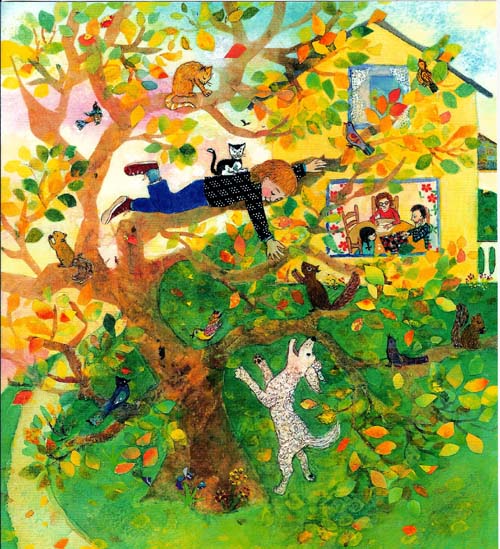
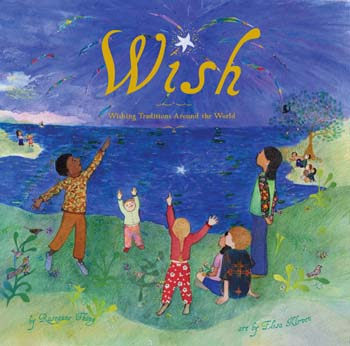 It probably goes without saying, then, that I’m thrilled she’s stopped by this morning for seven questions over breakfast, her breakfast-of-choice being “lots of strong coffee with a little soy milk; toast on warm mornings, vegetable soup on chilly ones.” And Elisa has a brand-new illustrated title to tell us about this morning, too: It’s an engaging non-fiction title called Wish: Wishing Traditions Around the World, written by Roseanne Thong and just published by Chronicle Books. This collection features wishing customs from fifteen countries that span the globe, providing a double-page spread for each and opening with a four-line poem before a paragraph explaining the wishing tradition. Sound like quintessential Elisa material to you, too? Children wishing, dreaming, hoping. It’s beautiful and seems to be Elisa at her best, but then I tend to think that with each and every book she creates.
It probably goes without saying, then, that I’m thrilled she’s stopped by this morning for seven questions over breakfast, her breakfast-of-choice being “lots of strong coffee with a little soy milk; toast on warm mornings, vegetable soup on chilly ones.” And Elisa has a brand-new illustrated title to tell us about this morning, too: It’s an engaging non-fiction title called Wish: Wishing Traditions Around the World, written by Roseanne Thong and just published by Chronicle Books. This collection features wishing customs from fifteen countries that span the globe, providing a double-page spread for each and opening with a four-line poem before a paragraph explaining the wishing tradition. Sound like quintessential Elisa material to you, too? Children wishing, dreaming, hoping. It’s beautiful and seems to be Elisa at her best, but then I tend to think that with each and every book she creates.
In this interview, she shares four spreads from the book (without the text), as well as many other illustrations and book spreads and many examples of the toys, dolls, and tapestries she’s created over the years. These tie directly into her illustration style and show that it has always been a folk-art one of intricate details and color.

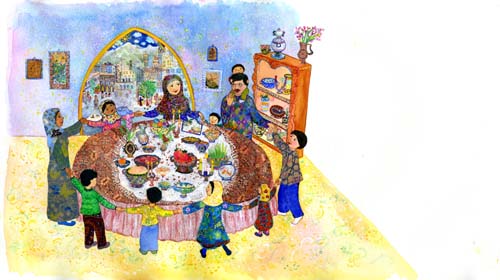
I have to give seven cheers for Elisa’s coffee selection this morning. Is there any other way to drink coffee than strong? Let’s get the basics while we set the table here and get out our mugs . . . Mmm.
7-Imp: Are you an illustrator or author/illustrator?
Elisa: I illustrate both my own and other authors’ texts.
7-Imp: Can you list your books-to-date?
Elisa:
- Wish: Wishing Traditions Around the World by Roseanne Thong (Chronicle, 2008)
- The Apple Doll (FSG, 2007)
- Sun Bread (Dutton, 2001)
- The Lion and the Little Red Bird (Dutton, 1992)
- The Paper Princess (Dutton, 1994)
- Ernst (Dutton, ’89; reissued by Tricycle Press, ’02)
- The Puddle Pail (Dutton, ’97; reissued by Tricycle Press, ’07)
- Abuela by Arthur Dorros (Dutton, ’91)
- De Colores and Other Latin American Folk Songs for Children by José Luis Orozco (Dutton, 1994)
- Our Big Home by Linda Glaser (Millbrook, 2000)
- A Carousel Tale (Tricycle, 2009)
and lots more…!
{Ed. Note: At Elisa’s web site, you can access a list of books she has written and illustrated and a list of books she has illustrated.}
7-Imp: What is your usual medium, or -– if you use a variety -– your preferred one?
Elisa: I use a variety of media, including watercolor, rapidograph or micron pens, a little pastel, a touch of acrylic, some colored pencil and lots of collage materials, from wool to origami paper to lace to…anything that works.
7-Imp: Where are your stompin’ grounds?
Elisa: I live in Albany, CA, which is next door to Berkeley. Just across the Bay are San Francisco, the wooded trails of Marin County, and wild beaches of Point Reyes National Seashore –my favorite places to go on weekends.
7-Imp: Can you briefly tell us about your road to publication?
 Elisa: When I was a very little kid, I announced that I wanted to be a “jelliest,” which was my own made up word for a children’s book author/illustrator. As a child and teenager, I constantly made things with my hands — dolls, toys, intricate Ukranian batiked and painted eggshells, tapestries, and sculptures out of clay, wire, and bread dough. Unfortunately, though, I didn’t practice DRAWING as much as a future “jelliest” ought to have. And instead of going to art school, I got a BA in English at U.C. Berkeley, and then a teaching credential. I liked teaching (fourth grade and art), but one summer I had an urge to go back to my dream of being a jelliest. (Sorry, this isn’t very brief.) I sent off some stories/book dummies, and the reactions I got from editors were that they liked the stories but thought that my self-taught art looked too naive. After much work, an editor accepted my pictures and published my first book. Another editor, the wonderful Donna Brooks, published my second book, Ernst, as well as about fifteen subsequent books. Now I work with a variety of publishers. Each book is an education!
Elisa: When I was a very little kid, I announced that I wanted to be a “jelliest,” which was my own made up word for a children’s book author/illustrator. As a child and teenager, I constantly made things with my hands — dolls, toys, intricate Ukranian batiked and painted eggshells, tapestries, and sculptures out of clay, wire, and bread dough. Unfortunately, though, I didn’t practice DRAWING as much as a future “jelliest” ought to have. And instead of going to art school, I got a BA in English at U.C. Berkeley, and then a teaching credential. I liked teaching (fourth grade and art), but one summer I had an urge to go back to my dream of being a jelliest. (Sorry, this isn’t very brief.) I sent off some stories/book dummies, and the reactions I got from editors were that they liked the stories but thought that my self-taught art looked too naive. After much work, an editor accepted my pictures and published my first book. Another editor, the wonderful Donna Brooks, published my second book, Ernst, as well as about fifteen subsequent books. Now I work with a variety of publishers. Each book is an education!
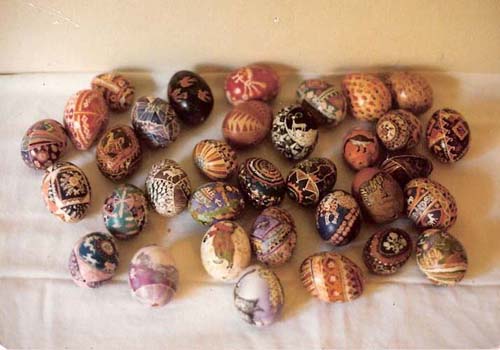

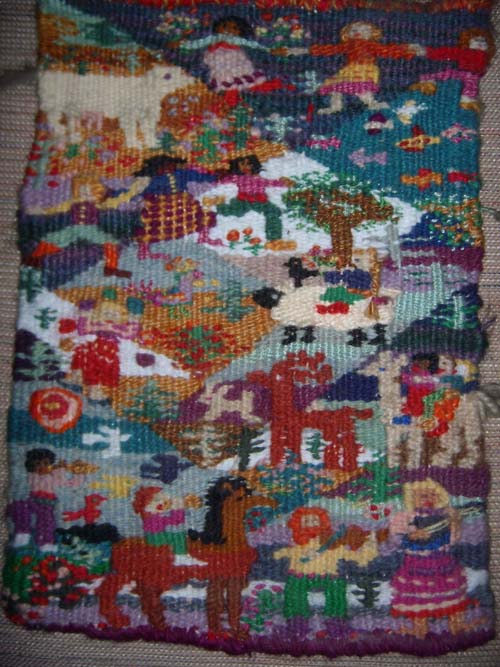
7-Imp: Can you please point us to your web site and/or blog?
Elisa: www.elisakleven.com
7-Imp: If you do school visits, tell us what they’re like.
Elisa: I draw and create stories with children. On a large pad, we think up characters, problems, and settings: the basics of fiction. I also show slides of my studio, family, pets, visual inspirations, and the toy worlds I made before I was a children’s book maker, and how they connect to my work in picture books. (There is more about this on my web site.) Sometimes I talk about how defective I felt when, as an adolescent, I still hadn’t outgrown a desire to bring little characters to life in my imagination and my hands, and about the relief I felt when it dawned on me that maybe I was an “artist” and not a big baby. I urge children to try to safeguard and nurture their imaginations, though the world doesn’t make this easy. And, while I appreciate children’s responsiveness to my books, it saddens me to see how starved so many of them are for art in their lives.
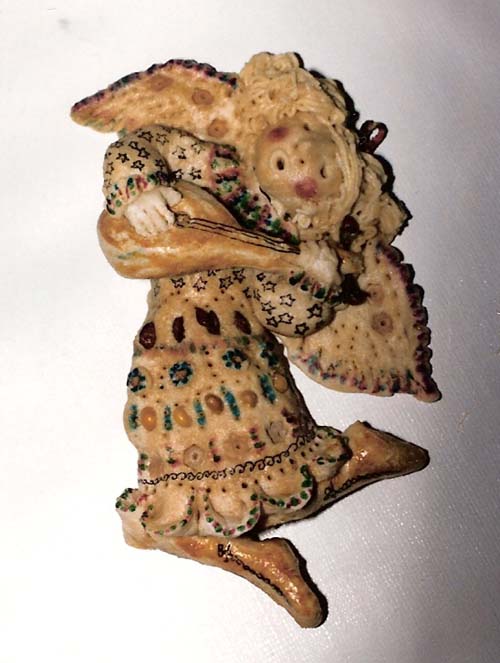
7-Imp: If you teach illustration, by chance, tell us how that influences your work as an illustrator.
Elisa: I haven’t taught illustration per se, but I often conduct collage work shops, which are similar to the programs I do with children. I try to get people—both little and grown—to create characters. If they say they can’t draw, I try to convince them that they can always make characters out of simple cut paper shapes, or even painted or drawn squiggles. Once my students have their characters, I urge them to start wondering about them: What do their characters wish for? Where do they live? What happens to them? Before long, stories are blooming and imaginary worlds are taking shape. People are empathizing with make-believe animals or children or objects, which is a big part of both childhood play and the creation of art and literature.
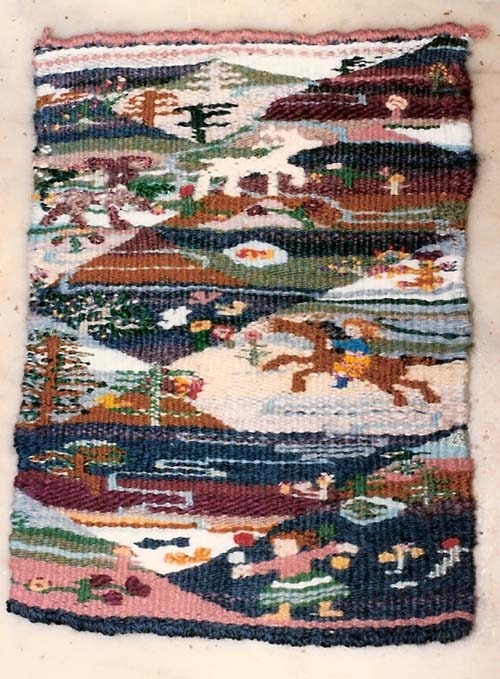
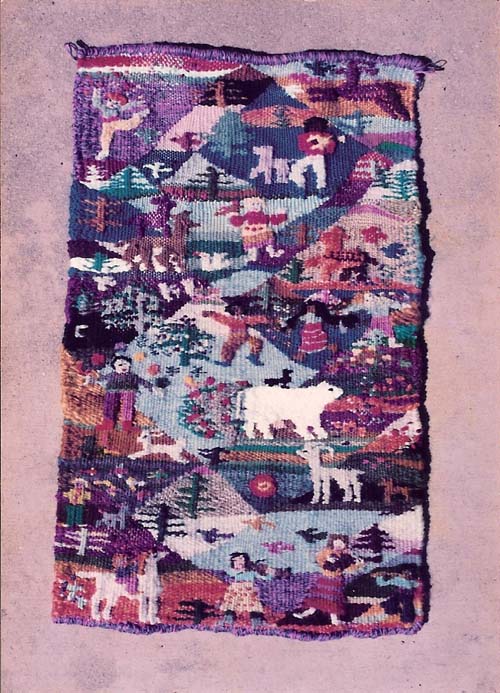
7-Imp: Any new titles/projects you might be working on now that you can tell us about?
 Elisa: I have just finished illustrations for a book by Thacher Hurd called The Weaver, to be published by FSG in Fall of ’09 (though it may be in Spring ’10). Thacher and I are friends, and many years ago I took a class from him about picture books. My newest published book is Wish: Wishing Traditions Around the World by Roseanne Thong (Chronicle, ’08), and I will have another book, A Carousel Tale, published by Tricycle in Spring ’09.
Elisa: I have just finished illustrations for a book by Thacher Hurd called The Weaver, to be published by FSG in Fall of ’09 (though it may be in Spring ’10). Thacher and I are friends, and many years ago I took a class from him about picture books. My newest published book is Wish: Wishing Traditions Around the World by Roseanne Thong (Chronicle, ’08), and I will have another book, A Carousel Tale, published by Tricycle in Spring ’09.
{Ed. Note: A preview illustration for A Carousel Tale is pictured here, and under that are some spreads from next year’s The Weaver.}


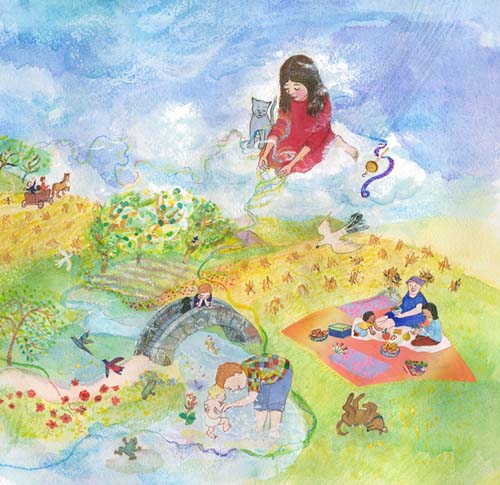
 Okay, the table’s set. We’re going to have a seat with our good, strong coffee. And we’re ready to talk more specifics. Many thanks again to Elisa for gracing our site today and for sharing so generously today.
Okay, the table’s set. We’re going to have a seat with our good, strong coffee. And we’re ready to talk more specifics. Many thanks again to Elisa for gracing our site today and for sharing so generously today.
1. 7-Imp: What exactly is your process when you are illustrating a book? You can start wherever you’d like when answering: getting initial ideas, starting to illustrate, or even what it’s like under deadline, etc. Do you outline a great deal of the book before you illustrate or just let your muse lead you on and see where you end up?
Elisa: I don’t have a real system, but in general I put my text in front of me and start breaking it up into pages. I make a thumbnail with tiny sketches and words on several pieces of paper. If I think the thumbnail is flowing well enough and can be put into the typical 32- or 40-page picture book format, I then go on to expand each little scene into a full-page picture. I try to give myself at least a day, and sometimes several, to ponder these scenes, composing them, researching the details, imagining what colors and textures they will have. Eventually, I compose a dummy from these scenes and send it off to my editor. Sometimes my finished pictures are pretty faithful to my original rough dummy drawings; often they change in the translation to colored art. A lot of spontaneous things and surprises happen when I come to make finished illustrations. When doing the finished art for a book, I usually start out slowly and hesitantly, but as the book ripens and nears completion, the images come very fast.

2. 7-Imp: Describe your studio or usual work space for us.
Elisa: I work in my former garage, which my husband and his dad, who’s a carpenter, transformed into a studio. It gets a little dusty and buggy, but I love the windows which look out into my yard, where a lemon tree grows and my cats and dogs laze in the sun.
3. 7-Imp: As book lovers, it interests us: What books or authors and/or illustrators influenced you as an early reader?
Elisa: Hans Christian Andersen. Laura Ingalls Wilder. E.B. White. Garth Williams. Hilary Knight and Kay Thompson. Dr. Seuss. Lois Lenski. Sydney Taylor. I.B. Singer. Marcia Brown. Roald Dahl. Leo Politi.
4. 7-Imp: If you could have three (living) illustrators or author/illustrators—whom you have not yet met—over for coffee or a glass of rich, red wine, whom would you choose?
Elisa: Too many to choose, but Maurice Sendak, Marc Simont, Christine Davenier, and Nancy Ekholm Burkert come to mind without without effort.
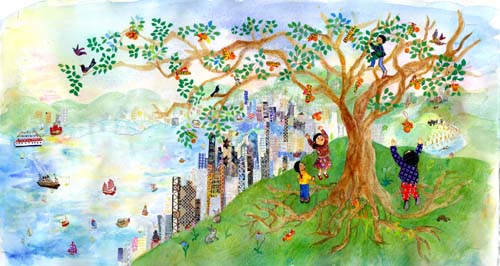
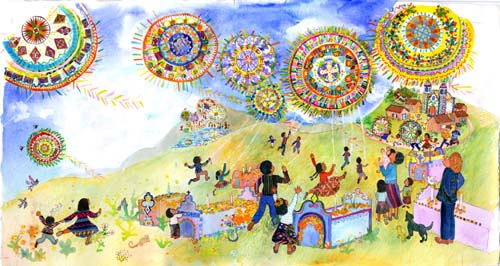
by Roseanne Thong; Chronicle, 2008.
5. 7-Imp: What is currently in rotation on your iPod or loaded in your CD player? Do you listen to music while you create books?
Elisa: I can’t listen while composing a picture (or a story), but once I’m painting/collaging, I love the company of music. My seventeen-year-old daughter and twleve-year-old son are sweet about making me eclectic mixes of my favorites, which include Dylan, Springsteen, Beethoven, Bach, Prokofiev, Labi Siffre, Paulo Conte, Levon Helm, The Persuasions, The Band, The Dixie Chicks, and even some of that new fangled hip hop stuff kids like nowadays. (I am a fogey!)
6. 7-Imp: What’s one thing that most people don’t know about you?
Elisa: My mom named me after a character in the H.C. Andersen fairy tale, “The Wild Swans.” This same mom, who died when I was fourteen, was an artist (etcher and printmaker), who created the anti-war image and words: WAR IS NOT HEALTHY FOR CHILDREN AND OTHER LIVING THINGS. I remember watching her draw the sunflower and shape the words when I was eight.

7. 7-Imp: Is there something you wish interviewers would ask you — but never do? Feel free to ask and respond here.
Elisa: “Do you have synesthesia?”
Yes, I do. In my mind, every letter and number comes with its own color. For example, “four” is a persimmony orange-red, and “D” is a the brown of dark chocolate.
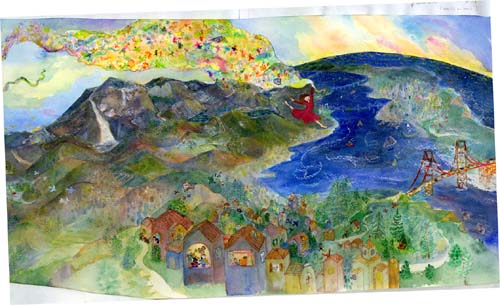
7-Imp: What is your favorite word?
Elisa: It’s a tie between “light,” “bright,” and “autumn.”
7-Imp: What is your least favorite word?
Elisa: “Nukular” with “factory farming” a close second.
7-Imp: What turns you on creatively, spiritually or emotionally?
Elisa: Natural beauty: Seasonal changes, starry skies, snow, wind, water, sunlight, clouds, leaves, flowers, almost all animal life, much human life, especially young. I am also moved by the sight of the Golden Gate Bridge (which I can see from my bedroom window) and the skylines of great cities.
7-Imp: What turns you off?
Elisa: Cruelty, injustice, corporate greed, non-recyclable trash, disbelief (especially feigned) in global warming.
7-Imp: What is your favorite curse word? (optional)
Elisa: Heavens — What a question! Actually, all of the tried and true words come in handy when needed.
7-Imp: What sound or noise do you love?
Elisa: The clip-clop of horses’ hooves; waves; birdsong.
7-Imp: What sound or noise do you hate?
Elisa: The yelp of dogs at the animal shelter; car alarms; nasty politicians’ lying voices.
7-Imp: What profession other than your own would you like to attempt?
Elisa: I would love to be a musician, or a painter who understands light and shadow, or a fearless pilot, or a scientist who comprehends the physical workings of the universe.
7-Imp: What profession would you not like to do?
Elisa: Worker in a meat-packing plant; prison warden.
7-Imp: If Heaven exists, what would you like to hear God say when you arrive at the Pearly Gates?
Elisa: “You’re going to love it here! It’s just as great as Earth, without the meanness or stupidity.”
All photos (with the exception of the coffee mug) courtesy of Elisa Kleven. All rights reserved.
The Paper Princess spread: Illustration from THE PAPER PRINCESS. Illustration © 1994 by Elisa Kleven. Published by Dutton. Posted with permission of Kleven. All rights reserved.
The Apple Doll spread: Illustration from THE APPLE DOLL. Illustration © 2007 by Elisa Kleven. Published by Farrar, Straus and Giroux. Posted with permission of Kleven. All rights reserved.
Four spreads from Wish: Illustrations from WISH: WISHING TRADITIONS AROUND THE WORLD by Roseanne Thong. Illustration © 2008 by Elisa Kleven. Published by Chronicle Books. Posted with permission of Kleven and publisher. All rights reserved.
Lion spread: Illustration from THE LION AND THE LITTLE RED BIRD. Illustration © 1992 by Elisa Kleven. Published by Dutton. Posted with permission of Kleven. All rights reserved.
Angel spread: Illustration from ANGELS WATCHING OVER ME by Julia Durango. Illustration © 2007 by Elisa Kleven. Published by Simon & Schuster. Posted with permission of Kleven. All rights reserved.
Carousel illustration: Illustration from A CAROUSEL TALE to be published in 2009 by Tricyle Press. Posted with permission of Kleven. All rights reserved.
Weaver spreads: Illustrations from THE WEAVER by Thacher Hurd to be published in 2009 or 2010 by Farrar, Straus and Giroux. Posted with permission of Kleven and publisher. All rights reserved.
Abuela spread: Illustration from ABUELA by Arthur Dorros. Illustration © 1991 by Elisa Kleven. Published by Dutton. Posted with permission of Kleven. All rights reserved.

Oh, dear. The urge to roll in paint again has become uncontrollable. I can imagine that Elisa Kleven’s synesthesia has taught her a different relationship to color in her art, and that difference is what makes her shine.
I don’t know that I’d manage to read a word of one of Elisa’s books; I’d be lost in the colors and textures and details. I love that the lion picking berries has a bag. I love that her older people look as merry as her youngest, and that the angels don’t wear white, and one has a mustache (why are angels always shown with no facial hair?). I love that her birds have patterns on their wings, and her trees have roots and shoots visible on both ends.
And what a wonderful thing that her mother is the one who came up with that quote!! And how proud she would be of her daughter, whose goals are to bring art and life and lightness to the world. What an impressive artist, and a great interview!
(And now I’m going to scout out an apple for an apple doll. That is TOO CUTE.)
[…] 1. Picture Book of the Day (Little Lost Bat) 2. Tricia (Bats by Gail Gibbons) 3. The Well-Read Child (The Lincolns: A Scrapbook Look at Abraham and Mary) 4. Jules, 7-Imp — interview w/Elisa Kleven w/art from her new illustrated non-fict […]
There’s so much to make me happy about in this interview…
1. The images. Good Lord, the colors. The busybusybusy activity (even in the ones with just one or two characters depicted).
2. The “jelliest” story. Aside from the fact that it’s a great word per se, I mean. It’s how a little kid — not every one, but many of them — really would form a new word, especially a new word which sorta sounds like it’s a real one (“I just had the jelliest sandwich ever!”) but actually means something utterly different.
3. The fact that there is actually a human tradition of wishing… and that someone has made a book about it!
Wow! You’ve definitely outdone yourself here. Great interview and images. I feel like my spirit has been bathed in a benevolent beauty and joy. What colors, patterns, textures. I can see why you had a difficult time trying to describe Elisa’s work. It’s all there, it’s so much, too much for mere words. Thanks for a beautiful start to a new week!
Thanks, you all. Elisa made the interview good w/her generosity in sharing images and illos and such.
JES, yes, the wishing book is great. My girls responded so well to it, too — talking all day long after first reading it about the different ways we wish.
Elisa Kleven’s work has been such a strong presence my life. As a children’s librarian, I’ve read The Lion and the Little Red Bird to countless children, and my own two daughters (now teenagers) wanted to hear The Paper Princess over and over. I even have a gorgeous framed print from City of Angels (by Julie Jaskol) hanging in my living room. Keep on making our world a more gorgeous place!
Jules,
Thanks for this wonderful interview with one of my and Grace Lin’s favorite picture book illustrators. Both Grace and I have Elisa Kleven originals that we bought in the Robert’s Snow fundraisers!!! I got Elisa’s beautiful snowflake in the 2007 auction.
Lucky me!
I’m glad to know I’m in good company. I have synesthesia, too.
Love, love, love Elisa Kleven’s work. She is my favorite illustrator. So thanks for the interview, guys!
Eva, I’m jealous of your print.
Elaine, I’m jealous of your snowflake.
(But I’m jealous in a happy-for-you-all way!).
Kelly, I remembered that Elisa is your favorite, and I thought of you while I worked on this interview.
Elisa’s bright art is the perfect antidote to a rainy, cold morning here in WNY, and I clearly must get my hands on a copy of Wish.
I want to fill my home with these beautiful illustrations. I suppose I will have to settle for the books instead. And the tapestries are stunning – if only I could crafts. Thank you for introducing me to a wonderful “jelliest”.
When my mom worked as a children’s librarian, she would read The Lion and the Little Red Bird to her preschool groups and talk about how people who don’t speak the same language can still be friends. I now have my mom’s copy to share with my daughter.
It’s funny– as a child, I never thought about the “War is not healthy…” graphic as being created by someone. It just was.
I love finding out about different people’s experiences of synasthesia. I’ve got the “ordinal linguistic personification” kind, where numbers, letters, months, etc. have their own personalities. Thank you, Elisa (and Jules and Eisha too!) for bringing to the surface this series of experiences.
This is an extraordinarily beautiful blog—and entry.
Kleven’s art is whimsical, inspired, and kid friendly–she understands what makes a character come to life for readers. As a bookseller I consider it an honor to put her books in customers waiting hands.
Thanks for sharing this interview!
I have been a fan since she visited my 4th grade class 15 or so years ago. I remember being amazed that she was illustrating with everyday materials like doilies.
Ten years later, when I was in college and wanting to be involved in making children’s books, I emailed Elisa to ask for advice. She very generously emailed me back with her phone number and suggested I give her a call.
She gave me lots of practical advice and names of some books to read. It meant so much to me that she would help out someone she didn’t even know. What a generous woman, and great artist!
[…] Elisa Kleven (interviewed October 27): “I urge children to try to safeguard and nurture their imaginations, though the world […]
[…] stop by our impish little art and literature salon, have some coffee with me (you may remember from my interview with her last October that she’s a fellow strong-coffee fan), and talk about some of the larger ideas […]
I was introduced to Elisa Klevens illustrations through the book B is for Bethlehem (Isabel Wilner)……..I was blown away by the visuals! How incredible. I am a retired art and religion teacher and have contemplated possibly illustrating and writing some childrens books myself. Elisa has set the bar so very high and she is quite an inspiration. I am inspired by color, sunshine and warmth……..and other wonderful illustrators!
[…] from Julia Durango’s Angels Watching Over Me, illustrated byElisa Kleven; Simon & Schuster, […]
[…] may remember Elisa both discussing this book, as well as sharing some early art from it, back in my October 2008 interview with her. (That’s one of my favorite interviews. I know, I know. I should probably act […]
[…] the book is a story by author Elka Weber, called One Little Chicken, illustrated by Elisa Kleven (Tricycle Press). It retells a story in the Talmud. Well, wait. I’ll let the author tell you […]
i am speechless. ms. kleven’s visuals are my dreams come to life. almost too beautiful to bear. magical, wonderful.
[…] Instead of featuring a brand-new picture book today or an up-and-coming illustrator, I’ve got artwork from one of my favorite picture book artists, Elisa Kleven. […]
[…] you.) And I can’t think of a better way to celebrate than by featuring author/illustrator Elisa Kleven’s newest picture book, Glasswings: A Butterfly’s Story (to be released by Dial this week), […]
Hi Elisa… Im Jim Dreiger’s wife. His Mom Frieda worked for your family when your Mom was creating War is Not Healthy… and I still have a print of that etching on my wall… Jim passed away last August here in Lindsay, CA… I am hoping to get your mailing address to send you a print you created with your sister Susie… it has the children… “In every child’s heart there is a song… I want to send this print to you as I am trying to downsize to move from our home…
Judyth
559 310-1593